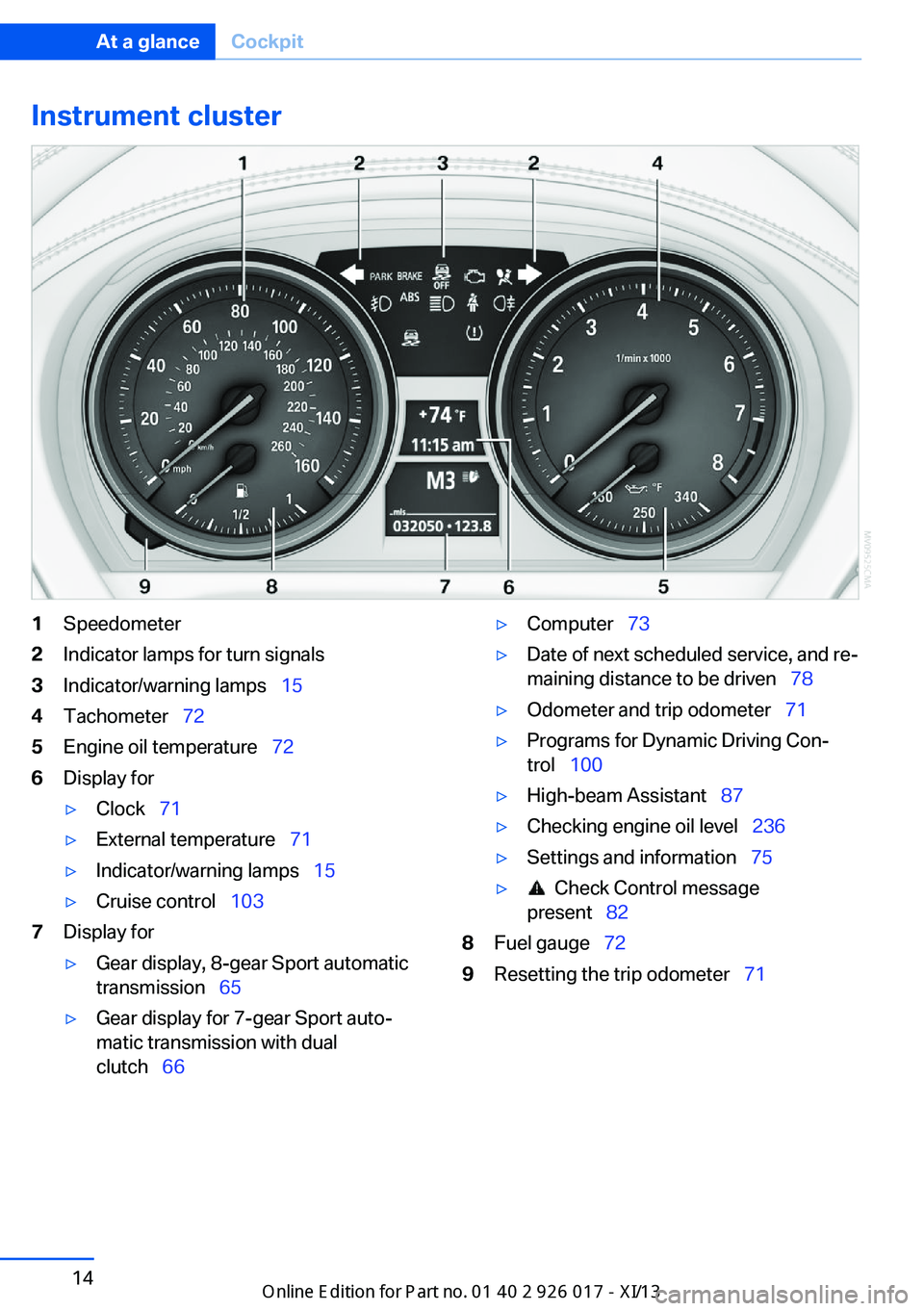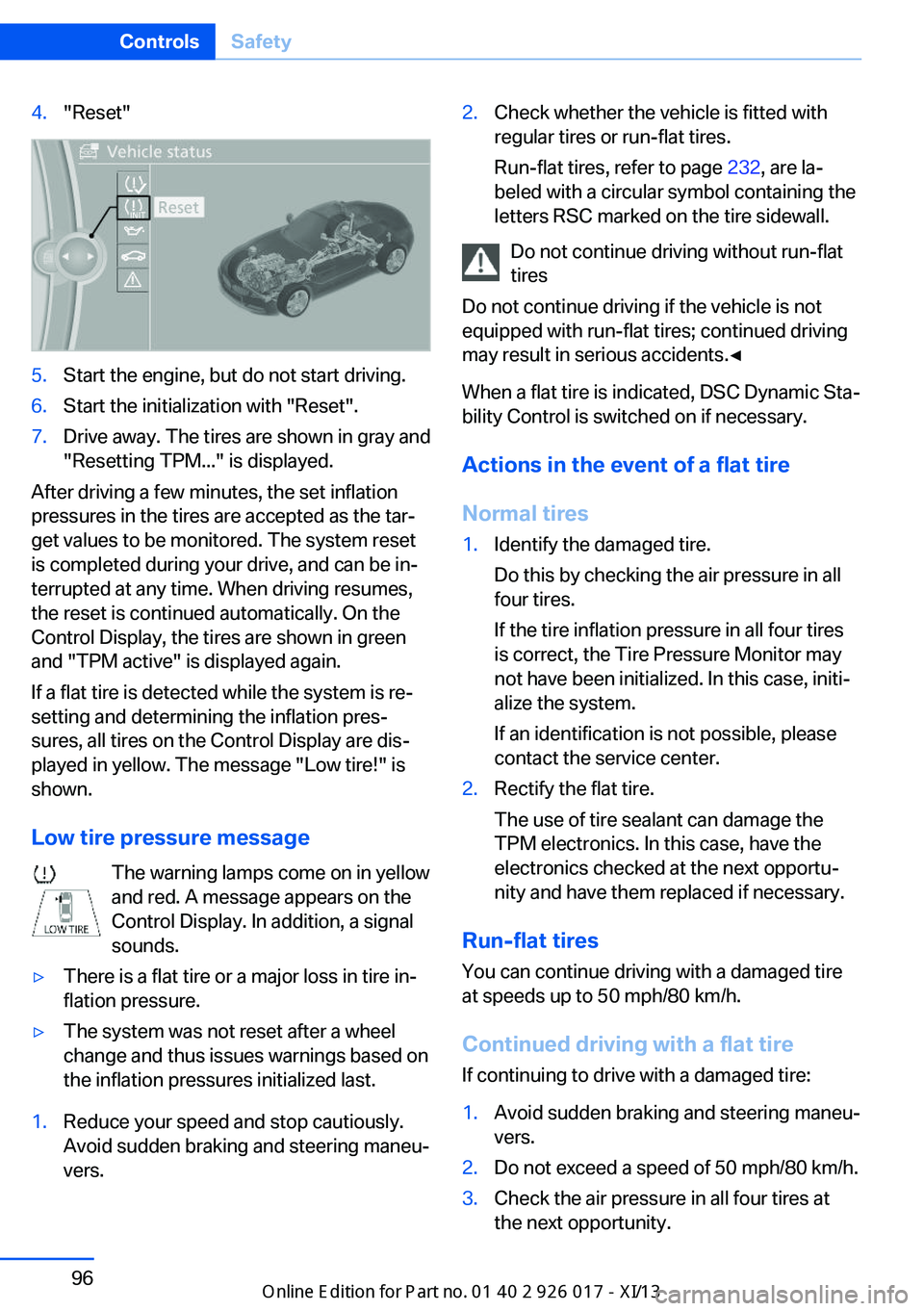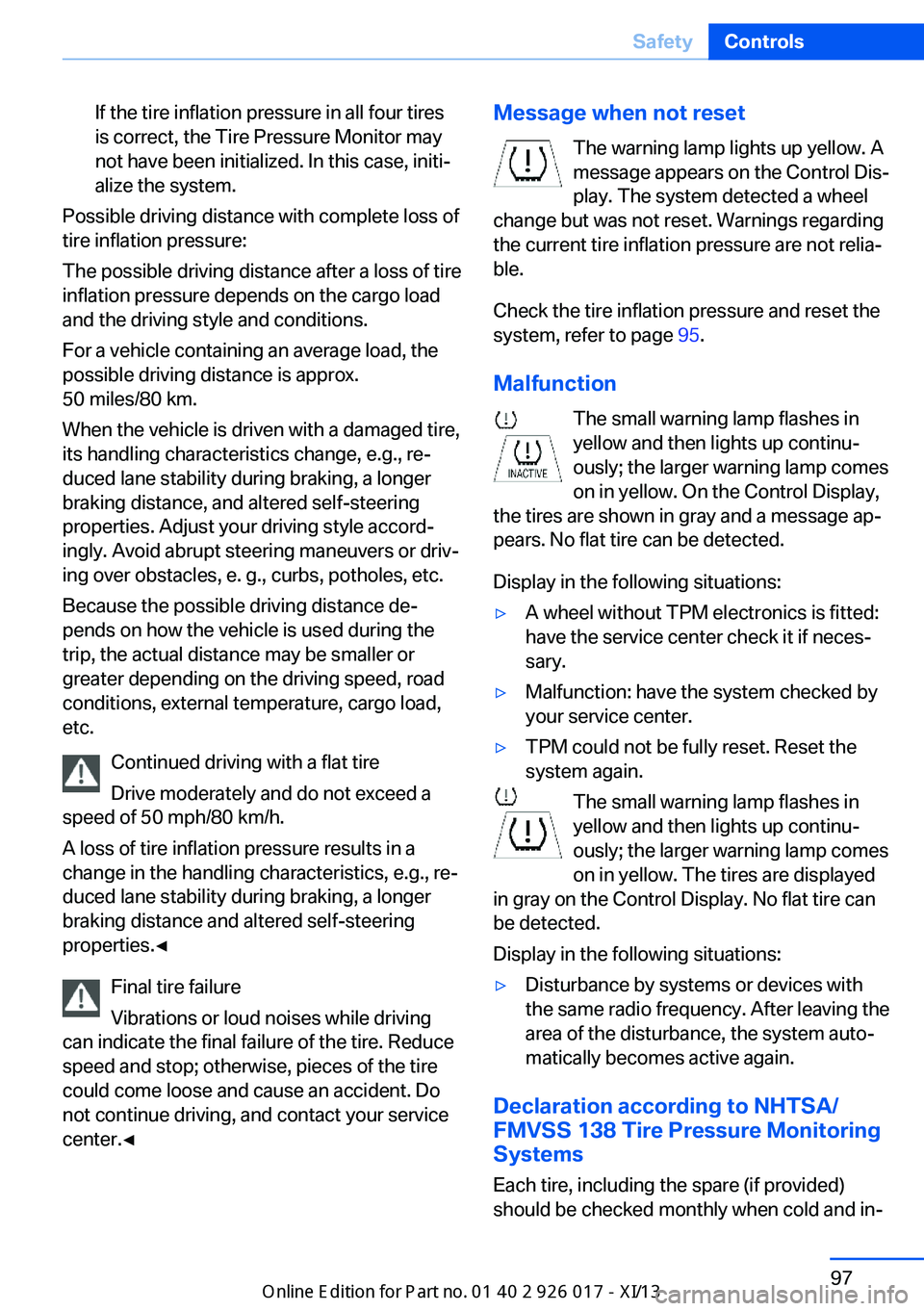service reset BMW Z4 2013 E89 Owner's Manual
[x] Cancel search | Manufacturer: BMW, Model Year: 2013, Model line: Z4, Model: BMW Z4 2013 E89Pages: 289, PDF Size: 6.86 MB
Page 18 of 289

Instrument cluster1Speedometer2Indicator lamps for turn signals3Indicator/warning lamps‚ÄÇ‚ÄÖ154Tachometer‚ÄÇ‚ÄÖ725Engine oil temperature‚ÄÇ‚ÄÖ 726Display for‚ñ∑Clock‚ÄÇ‚ÄÖ71‚ñ∑External temperature‚ÄÇ‚ÄÖ 71‚ñ∑Indicator/warning lamps‚ÄÇ‚ÄÖ 15‚ñ∑Cruise control‚ÄÇ‚ÄÖ1037Display for‚ñ∑Gear display, 8-gear Sport automatic
transmission‚ÄÇ‚ÄÖ 65‚ñ∑Gear display for 7-gear Sport auto‚Äê
matic transmission with dual
clutch‚ÄÇ‚ÄÖ 66‚ñ∑Computer‚ÄÇ‚ÄÖ 73‚ñ∑Date of next scheduled service, and re‚Äê
maining distance to be driven‚ÄÇ‚ÄÖ 78‚ñ∑Odometer and trip odometer‚ÄÇ‚ÄÖ71‚ñ∑Programs for Dynamic Driving Con‚Äê
trol‚ÄÇ‚ÄÖ 100‚ñ∑High-beam Assistant‚ÄÇ‚ÄÖ 87‚ñ∑Checking engine oil level‚ÄÇ‚ÄÖ 236‚ñ∑Settings and information‚ÄÇ‚ÄÖ75‚ñ∑ Check Control message
present‚ÄÇ‚ÄÖ 828Fuel gauge‚ÄÇ‚ÄÖ 729Resetting the trip odometer‚ÄÇ‚ÄÖ 71Seite 14At a glanceCockpit14
Online Edition for Part no. 01 40 2 911 315 - VI/13
Page 100 of 289

4."Reset"5.Start the engine, but do not start driving.6.Start the initialization with "Reset".7.Drive away. The tires are shown in gray and
"Resetting TPM..." is displayed.
After driving a few minutes, the set inflation
pressures in the tires are accepted as the tar‚Äê
get values to be monitored. The system reset
is completed during your drive, and can be in‚Äê
terrupted at any time. When driving resumes,
the reset is continued automatically. On the
Control Display, the tires are shown in green
and "TPM active" is displayed again.
If a flat tire is detected while the system is re‚Äê
setting and determining the inflation pres‚Äê
sures, all tires on the Control Display are dis‚Äê
played in yellow. The message "Low tire!" is
shown.
Low tire pressure message The warning lamps come on in yellow
and red. A message appears on the
Control Display. In addition, a signal
sounds.
‚ñ∑There is a flat tire or a major loss in tire in‚Äê
flation pressure.‚ñ∑The system was not reset after a wheel
change and thus issues warnings based on
the inflation pressures initialized last.1.Reduce your speed and stop cautiously.
Avoid sudden braking and steering maneu‚Äê
vers.2.Check whether the vehicle is fitted with
regular tires or run-flat tires.
Run-flat tires, refer to page 232, are la‚Äê
beled with a circular symbol containing the
letters RSC marked on the tire sidewall.
Do not continue driving without run-flat
tires
Do not continue driving if the vehicle is not
equipped with run-flat tires; continued driving
may result in serious accidents.‚óÄ
When a flat tire is indicated, DSC Dynamic Sta‚Äê
bility Control is switched on if necessary.
Actions in the event of a flat tire Normal tires
1.Identify the damaged tire.
Do this by checking the air pressure in all
four tires.
If the tire inflation pressure in all four tires
is correct, the Tire Pressure Monitor may
not have been initialized. In this case, initi‚Äê
alize the system.
If an identification is not possible, please
contact the service center.2.Rectify the flat tire.
The use of tire sealant can damage the
TPM electronics. In this case, have the
electronics checked at the next opportu‚Äê
nity and have them replaced if necessary.
Run-flat tires
You can continue driving with a damaged tire
at speeds up to 50 mph/80 km/h.
Continued driving with a flat tire If continuing to drive with a damaged tire:
1.Avoid sudden braking and steering maneu‚Äê
vers.2.Do not exceed a speed of 50 mph/80 km/h.3.Check the air pressure in all four tires at
the next opportunity.Seite 96ControlsSafety96
Online Edition for Part no. 01 40 2 911 315 - VI/13
Page 101 of 289

If the tire inflation pressure in all four tires
is correct, the Tire Pressure Monitor may
not have been initialized. In this case, initi‚Äê
alize the system.
Possible driving distance with complete loss of
tire inflation pressure:
The possible driving distance after a loss of tire
inflation pressure depends on the cargo load
and the driving style and conditions.
For a vehicle containing an average load, the
possible driving distance is approx.
50 miles/80 km.
When the vehicle is driven with a damaged tire,
its handling characteristics change, e.g., re‚Äê
duced lane stability during braking, a longer
braking distance, and altered self-steering
properties. Adjust your driving style accord‚Äê
ingly. Avoid abrupt steering maneuvers or driv‚Äê
ing over obstacles, e. g., curbs, potholes, etc.
Because the possible driving distance de‚Äê
pends on how the vehicle is used during the
trip, the actual distance may be smaller or
greater depending on the driving speed, road
conditions, external temperature, cargo load,
etc.
Continued driving with a flat tire
Drive moderately and do not exceed a
speed of 50 mph/80 km/h.
A loss of tire inflation pressure results in a
change in the handling characteristics, e.g., re‚Äê
duced lane stability during braking, a longer
braking distance and altered self-steering
properties.‚óÄ
Final tire failure
Vibrations or loud noises while driving
can indicate the final failure of the tire. Reduce
speed and stop; otherwise, pieces of the tire
could come loose and cause an accident. Do
not continue driving, and contact your service
center.‚óÄ
Message when not reset
The warning lamp lights up yellow. A
message appears on the Control Dis‚Äê
play. The system detected a wheel
change but was not reset. Warnings regarding
the current tire inflation pressure are not relia‚Äê
ble.
Check the tire inflation pressure and reset the
system, refer to page 95.
Malfunction The small warning lamp flashes in
yellow and then lights up continu‚Äê
ously; the larger warning lamp comes
on in yellow. On the Control Display,
the tires are shown in gray and a message ap‚Äê
pears. No flat tire can be detected.
Display in the following situations:‚ñ∑A wheel without TPM electronics is fitted:
have the service center check it if neces‚Äê
sary.‚ñ∑Malfunction: have the system checked by
your service center.‚ñ∑TPM could not be fully reset. Reset the
system again.
The small warning lamp flashes in yellow and then lights up continu‚Äê
ously; the larger warning lamp comes
on in yellow. The tires are displayed
in gray on the Control Display. No flat tire can
be detected.
Display in the following situations:
‚ñ∑Disturbance by systems or devices with
the same radio frequency. After leaving the
area of the disturbance, the system auto‚Äê
matically becomes active again.
Declaration according to NHTSA/
FMVSS 138 Tire Pressure Monitoring
Systems
Each tire, including the spare (if provided)
should be checked monthly when cold and in‚Äê
Seite 97SafetyControls97
Online Edition for Part no. 01 40 2 911 315 - VI/13